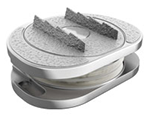The term “Fusion” means healing with bone. When you break a leg bone, it heals by fusing. When the spine fuses, it heals with bone as well. Bone needs stability to heal or ‘fuse.’ This is why we put a broken leg in a cast or a metal rod down the middle of the bone. Spine bones need stability to grow bone and fuse as well. In the old days, patients were left in bed for months or actually put in back casts! Now, with modern technology, we are able to put bracing on the inside with surgery and have patients wear removable braces on the outside to promote bone healing and spine fusion.
When is Spine Fusion Needed?
If there is instability or deformity in the spine, healing with bone, or fusion is needed.
Examples:
Deformity of the spine caused by scoliosis- The abnormal curvature is corrected and held in place by titanium rods until the spine grows bone and fuses in this position. Occasionally these rods are removed, but only if they are causing discomfort.
Arthritis: when the joints of the spine wear out from arthritis, they can become incompetent and cause slipping of the spine. The body tries to heal this arthritis by growing more bone in an attempt to fuse itself. These spurs can crowd the nerves and cause nerve pain.
Spondylolisthesis is the term used for slipping of the spine. When we remove the bone spurs from the pinched nerves, we have to put bracing in to support the spine so the spine can fuse in that position. The spine tries to heal itself by growing bone!
This is the same type of arthritis that affects the hips or the knees causing total joint replacement.
Unfortunately, we do not have spine replacement surgery!
Motion preservation is always the goal of spine care whenever possible.
Disc Replacement (ADR) is a less invasive alternative that removes the damaged disc and replaces it with an artificial implant designed to mimic the function of a healthy disc. This preserves the motion of the spine while treating pain and lowering the risks future adjacent level degeneration.
Is It Possible for Spinal Fusion Surgery to Fail?
Some will say “Spinal fusion surgery has a high overall success rate”. With modern technology, there is a very high rate of successful fusion. Yet, there are factors that can delay fusion or result in a non union, age, smoking, diabetes, and obesity are the top culprits.
Possible Complications of Spinal Fusion
Complications of spinal fusion are not rare. They are higher in patients who smoke, have diabetes or are obese. If it is determined that a patient has a delayed union, a bone stimulator machine is often ordered to promote healing.
Adjacent segment disease (ASD): After a spinal fusion, patients have approximately a 4% per year risk of developing degeneration at an adjacent level. This is thought to occur in part due to the increased stress on those segments from the loss of motion at the fused joint. Treatment may become necessary to address the new level issues.
Chronic pain: Spinal fusion can be an option to treat chronic back pain that hasn’t responded to other treatments. However, it is possible for chronic pain to fail to improve or even get worse, or for new pain to develop. The key is the right diagnosis. Most people over age 40 will have degenerative changes on their spine x-rays, however very few of these people have significant back pain. Thorough evaluation and review of x-rays and MRIs is important to treat the pain generator.
Reduced mobility: In a successful one level spinal fusion, there is significant motion loss.
Beyond Physical Side Effects
Chronic pain wears on the emotional health. Fear of surgery or fear of potential side effects can often delay needed surgery. I always advise patients to ‘be educated and nervous, not terrified.’ No one wants surgery. The risk versus benefit discussion is critical. Only patients know how they feel and how much their lives are affected.
Finding Alternatives to Spinal Fusion
Physical therapy, medication, weight loss, pool exercise, back braces, and spinal injections are always used to get people in the “happy zone!” If all of these non-operative tools are not enough, then we consider what surgical options are available.
Expert Spine Care
If your chronic back pain isn’t responding to the treatments you’ve tried, and you’re worried that spinal fusion may be next, schedule an evaluation
